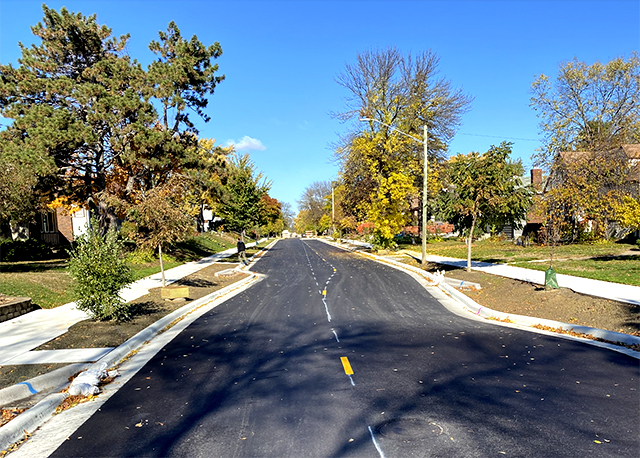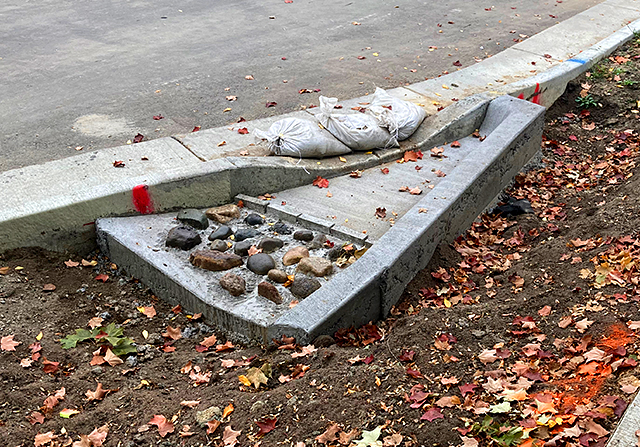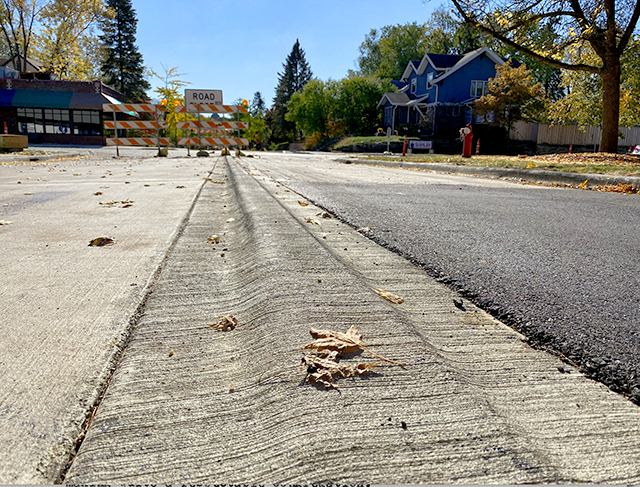Most of the time, street maintenance projects only scratch the surface. Every fifteen years or so, any given street in Minneapolis gets a “mill and overlay,” the most common kind of repair. A public works crew shows up to mill off and replace the surface asphalt. The process takes about two weeks, and if you’re lucky, the public works’ department will throw in a few new ADA sidewalks.
But full street reconstructions are a much more expensive story. Even if the city budget is in good shape, they only happen once every 50 years. Because the teams redo the street foundation, including all the utilities, it’s a months-long process. But on the other hand, engineers redesign the street in any way they want. For urban planners, that’s when the fun begins.
Any day now, Minneapolis Public Works will unveil two new street reconstructions featuring a few concrete tricks never before seen in the Twin Cities. On both Plymouth Avenue North and Grand Avenue South, folks walking, rolling, or driving will experience the kind of street design you normally find in Europe, a sign that Minneapolis is breaking new ground on next-level traffic calming.
Article continues after advertisement
Medians for horizontal deflection
Here’s a quick rundown of the shiny new features in both of these projects. First, the half-mile reconstruction of Plymouth Avenue, a key East-West corridor through North Minneapolis. The project runs from Wirth Park to Penn Avenue.
The most obvious changes to Plymouth Avenue are the medians. The designers included no less than four “island medians” standing proudly in the middle of the street, intended to slow down drivers and give people on foot safe places to cross.
“We needed something to have a vertical element in the street, and found that the medians were the correct tool,” explained Nathan Koster, who is a Transportation Planning Manager for the public works department. “They provide horizontal deflection, where people have to move to the side, but also shorten the crossing distance, allowing people to cross one lane at a time.”
“Horizontal deflection” sounds like when you’re avoiding someone at a cocktail party, but it’s actually the simple principle that drivers slow down to avoid obstacles. The medians are part of a package of concrete measures aimed at reducing the “design speed” of Minneapolis streets, in the hopes of reducing fatalities and crashes. By including so many islands, ideally the speedometers on Plymouth might begin to vaguely resemble the city-wide speed limits.
Tabled intersections
The medians are an obvious change, but unless you’re on the sidewalks or side streets, you might not notice the so-called “tabled intersections.” These are another of Koster’s vertical elements, giving the street a few inches of difference to warn drivers that they’re entering a space containing a bike lane and crosswalk.
“One of the new things in TAP [the city Transportation Action Plan] and [Minneapolis] Street Design Guide are these raised crossings,” Koster explained. “They provide a visual and vertical cue. Reinforcing design and safety together, hand in hand, provides a very smooth level crossing imperceptibly as you’re walking and rolling across these intersections on the side streets.”

MinnPost photo by Bill Lindeke
“Tabled intersections” give the street a few inches of difference to warn drivers that they’re entering a space containing a bike lane and crosswalk.
Article continues after advertisement
Chicanery on Grand
On the other side of town, Grand Avenue runs north-south through the Lyndale and Kingfield neighborhoods. The relatively low-traffic artery features small-scale retail gems like Victor’s 1959 Café and Patisserie 46, alongside a dozen other small shops. Two-and-a-quarter-miles of new street are about to be unveiled, and folks in for a treat: the city’s first chicanes.

MinnPost photo by Bill Lindeke
Chicanes are alternating bump outs that force drivers to swerve, while swapping parking from one side of the street to the other.
Chicanes are a term familiar to fans of Formula 1 racing, but are probably new to most Minneapolis drivers. They’re alternating bump outs that force drivers to swerve, while swapping parking from one side of the street to the other. Along with the 10-foot driving lanes, a new, narrower standard for the city, the design uses infrastructure to discourage speeding and boost safety.

MinnPost photo by Tom Nehil
A surprise in the center
Probably the most creative thing about the street is a tiny detail in the middle of the concrete intersection: a “raised centerline.” In all my years of focusing on street designs, I never imagined such a thing was possible. I got down on my hands and knees to inspect, and there was an inch or so of concrete sticking up in the between the two 10’ lanes of traffic

MinnPost photo by Bill Lindeke
Nathan Koster assured me that thanks to the shovel nose (named for the fish), the city plows should handle them just fine in the wintertime.
Unlike most commercial two-lane streets, in the redesign the buses will stay “in the lane,” discouraging drivers from passing. It’s a principle familiar to folks who’ve ridden the city’s arterial Bus Rapid Transit routes, but doing so on a street like Grand is a subtle change in favor of transit.
Article continues after advertisement
Slowing cars
Speed bumps are jokingly referred to as “sleeping policemen,” because they work 24/7 to slow down motor vehicles. Especially in an era when police enforcement has become so problematic, it’s all the more important to design streets that will do the job of a dozen cops, reducing speeding and crashes without the need for sirens and traffic stops. The suite of design tweaks revealed by Minneapolis Public Works’ new streets represents a whole new kind of public safety.
Slowly over the next few years, Minneapolitans should expect to see more of these new street changes as reconstructions continue apace. Next year, Nathan Koster tells me that Bryant Avenue South and Franklin Avenue will be in the queue to get next-level traffic calming. If Grand and Plymouth are a sign of things to come, we’ll finally start to see city streets that reflects the mobility and safety priorities long championed by Minneapolis plans.
"complete" - Google News
November 02, 2021 at 02:00PM
https://ift.tt/3bGdFaC
With two complete street rebuilds, Minneapolis is taking traffic calming to the next level - MinnPost
"complete" - Google News
https://ift.tt/2Fvz4Dj
https://ift.tt/2YviVIP

No comments:
Post a Comment